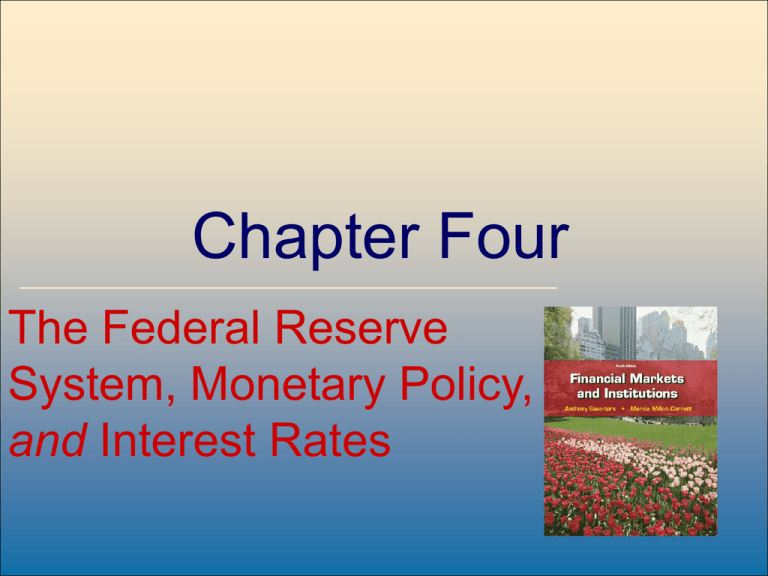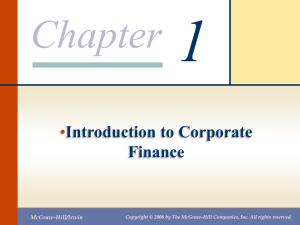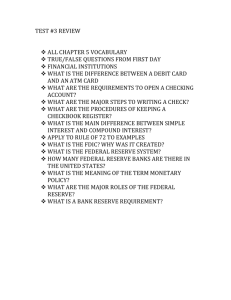
Chapter Four
The Federal Reserve
System, Monetary Policy,
and Interest Rates
McGraw-Hill/Irwin
4-1
©2009, The McGraw-Hill Companies, All Rights Reserved
The Federal Reserve
• Founded by Congress under the Federal
Reserve Act in 1913
• Subject to oversight by Congress under
its authority to coin money
• An independent central bank–its
decisions do not have to be ratified by
the President
McGraw-Hill/Irwin
4-2
©2009, The McGraw-Hill Companies, All Rights Reserved
Functions of the Federal Reserve
• Conduct monetary policy
• Supervise and regulate depository
institutions
• Maintain financial system stability
• Provide payment and other financial
services to the U.S. government, the
public, FIs, and foreign official
institutions
McGraw-Hill/Irwin
4-3
©2009, The McGraw-Hill Companies, All Rights Reserved
Structure of the Federal Reserve
• Divided into 12 Federal Reserve districts, each
with a main Federal Reserve Bank
• Federal Reserve Banks operate under the
general supervision of the Board of Governors
of the Federal Reserve
• The Office of the Comptroller of the Currency
(OCC) charters national banks, which are
members of the Federal Reserve System (FRS)
• FRS member banks “own” the 12 Federal
Reserve Banks
McGraw-Hill/Irwin
4-4
©2009, The McGraw-Hill Companies, All Rights Reserved
Board of Governors of the FRS
• Seven member board headquartered in
Washington, DC
• President appoints and Senate confirms
members to nonrenewable 14-year terms
• President appoints and Senate confirms
Chairman and vice-chairman to renewable 4year terms
• Formulates and conducts monetary policy and
supervises and regulates banks
McGraw-Hill/Irwin
4-5
©2009, The McGraw-Hill Companies, All Rights Reserved
Federal Open Market Committee (FOMC)
• FOMC consists of 12 members
– seven members of the Board of Governors
– the president of the Federal Reserve Bank of NY
– the presidents of four other Federal Reserve Banks (on
a rotating basis)
• The monetary policy-making body of the FRS
• Policies seek to promote full employment,
economic growth, price stability, and a
sustainable pattern of international trade
McGraw-Hill/Irwin
4-6
©2009, The McGraw-Hill Companies, All Rights Reserved
Federal Open Market Committee (FOMC)
• The FOMC sets ranges for growth of monetary
aggregates and the fed funds rate, and also
directs FR operations in FX markets
• Open market operations are the main policy
tool used to achieve monetary targets
– involve the purchase and sale of U.S. government and
federal agency securities
– are implemented by the Federal Reserve Board Trading
Desk of the New York Federal Reserve Bank
McGraw-Hill/Irwin
4-7
©2009, The McGraw-Hill Companies, All Rights Reserved
Federal Reserve Banks
• Assist in the conduct of monetary policy
– set and change the discount rate (must be approved by the Board
of Governors)
– make discount window loans to depository institutions
• Supervise and regulate FRS member banks
– conduct examinations and inspections of member banks
– issue warnings when banking activity is unsafe or unsound
– approve bank mergers and acquisitions
• Provide government services
– act as the commercial banks of the U.S. Treasury
McGraw-Hill/Irwin
4-8
©2009, The McGraw-Hill Companies, All Rights Reserved
Federal Reserve Banks
• Issue new currency
– collect and replace currency in circulation as necessary
• Clear checks
– act as a central clearing system for U.S. banks
– clear ~25% of all checks written in the U.S.
• Provide wire transfer services
– Fedwire
– Automated Clearinghouse (ACH)
• Perform banking sector and economic research
– used in the formulation of monetary policy
McGraw-Hill/Irwin
4-9
©2009, The McGraw-Hill Companies, All Rights Reserved
Balance Sheet of the Federal Reserve
• Major assets
–
–
–
–
Treasury securities
Treasury currency
gold and foreign exchange
loans to domestic banks
• Major liabilities
– reserves
– currency in circulation
– currency in circulation + reserves = money base
McGraw-Hill/Irwin
4-10
©2009, The McGraw-Hill Companies, All Rights Reserved
Please insert Table 4-5 here.
McGraw-Hill/Irwin
4-11
©2009, The McGraw-Hill Companies, All Rights Reserved
Monetary Policy
• Monetary policy affects the
macroeconomy by influencing the supply
and demand for excess bank reserves
– influences the money supply and the level of
short-term and long-term interest rates
– affects foreign exchange rates, the amount of
money and credit in the economy, and the
levels of unemployment, output, and prices
McGraw-Hill/Irwin
4-12
©2009, The McGraw-Hill Companies, All Rights Reserved
Monetary Policy
• Open market operations
– policy directive of the FOMC is forwarded to
the Federal Reserve Board Trading Desk at the
Federal Reserve Bank of New York
– Trading Desk manager buys or sells U.S.
Treasury securities in the over-the-counter
(OTC) market, which keeps the fed funds rate
near its desired target
McGraw-Hill/Irwin
4-13
©2009, The McGraw-Hill Companies, All Rights Reserved
Monetary Policy
• Open market operations (cont’d)
– FRBNY acts through the Trading Desk to
implement policy directives each business day
– operations may be permanent or temporary
– may use repurchase agreements for temporary
increases or decreases in excess reserves
McGraw-Hill/Irwin
4-14
©2009, The McGraw-Hill Companies, All Rights Reserved
Monetary Policy
• The discount rate is the rate Federal Reserve
Banks charge on loans to depository
institutions in their district
• The Federal Reserve rarely uses the discount
rate as a policy tool
– discount rate changes are strong signals of the Federal
Reserves intentions
– there is no guarantee that banks will borrow
McGraw-Hill/Irwin
4-15
©2009, The McGraw-Hill Companies, All Rights Reserved
Monetary Policy
• Reserve requirements are the reserve assets
depository institutions must keep to “back”
transaction deposits
– reserve assets include vault cash and deposits at
Federal Reserve Banks
• The multiplier effect
1
in money supply
new reserve requiremen t ratio
McGraw-Hill/Irwin
4-16
in reserves
©2009, The McGraw-Hill Companies, All Rights Reserved
Monetary Policy
• Expansionary monetary policy
– open market purchases of securities by the Fed
– discount rate decreases
– reserve requirement ratio decreases
• Contractionary monetary policy
– open market sales of securities by the Fed
– discount rate increases
– reserve requirement ratio increases
McGraw-Hill/Irwin
4-17
©2009, The McGraw-Hill Companies, All Rights Reserved
Money Supply versus
Interest Rate Targeting
Interest
Rate
i’=8%
Interest
Rate
MS
MS
iT = 6%
i*=6%
i’’= 5%
i’’=4%
MD’
MD
MD’’
MS
McGraw-Hill/Irwin
MS’
Quantity of Money
4-18
MD’
MD
MD’’
Quantity of Money
©2009, The McGraw-Hill Companies, All Rights Reserved
International Monetary Policy
• The Federal Reserve generally allows
foreign exchange rates to fluctuate freely
• Foreign exchange intervention
– commitments between countries about the
institutional aspects of their intervention in the
foreign exchange markets
– similar to open market purchases and sales of
Treasury securities
McGraw-Hill/Irwin
4-19
©2009, The McGraw-Hill Companies, All Rights Reserved
Major Foreign Central Banks
• The Bank of Japan
– loose monetary policy is fueling an economic recovery
• The European Central Bank
– recently switched from targeting the money supply to
targeting inflation
• The People’s Bank of China
– interest rates are becoming a more important policy
tool as China moves to a market oriented financial
system
McGraw-Hill/Irwin
4-20
©2009, The McGraw-Hill Companies, All Rights Reserved





